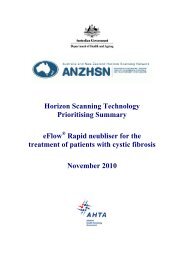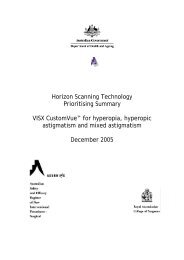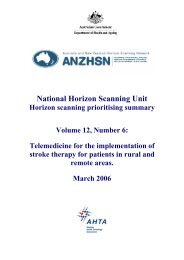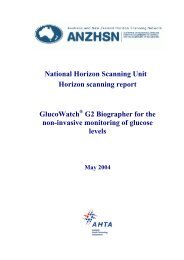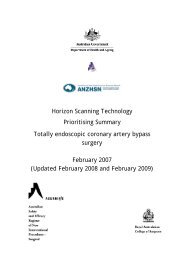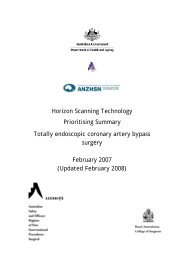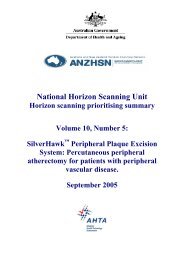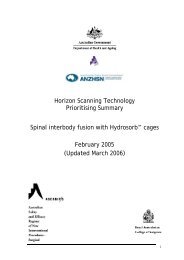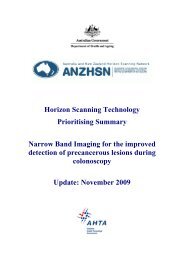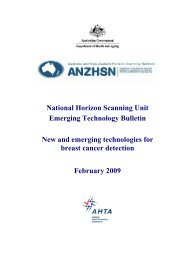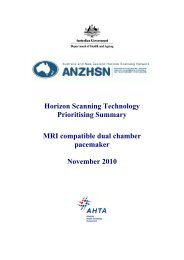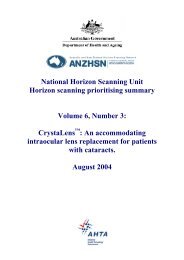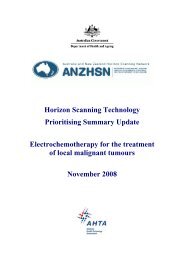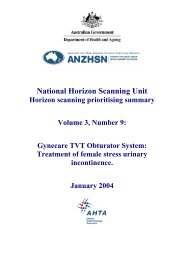Mini-cardiopulmonary bypass system - the Australia and New ...
Mini-cardiopulmonary bypass system - the Australia and New ...
Mini-cardiopulmonary bypass system - the Australia and New ...
Create successful ePaper yourself
Turn your PDF publications into a flip-book with our unique Google optimized e-Paper software.
Horizon Scanning Technology<br />
Prioritising Summary<br />
<strong>Mini</strong>-<strong>cardiopulmonary</strong> <strong>bypass</strong> <strong>system</strong><br />
May 2008
© Commonwealth of <strong>Australia</strong> 2008<br />
ISBN<br />
Publications Approval Number:<br />
This work is copyright. You may download, display, print <strong>and</strong> reproduce this material in<br />
unaltered form only (retaining this notice) for your personal, non-commercial use or use within<br />
your organisation. Apart from any use as permitted under <strong>the</strong> Copyright Act 1968, all o<strong>the</strong>r rights<br />
are reserved. Requests <strong>and</strong> inquiries concerning reproduction <strong>and</strong> rights should be addressed to<br />
Commonwealth Copyright Administration, Attorney General’s Department, Robert Garran<br />
Offices, National Circuit, Canberra ACT 2600 or posted at http://www.ag.gov.au/cca<br />
Electronic copies can be obtained from http://www.horizonscanning.gov.au<br />
Enquiries about <strong>the</strong> content of <strong>the</strong> report should be directed to:<br />
HealthPACT Secretariat<br />
Department of Health <strong>and</strong> Ageing<br />
MDP 106<br />
GPO Box 9848<br />
Canberra ACT 2606<br />
AUSTRALIA<br />
DISCLAIMER: This report is based on information available at <strong>the</strong> time of research cannot be<br />
expected to cover any developments arising from subsequent improvements health technologies.<br />
This report is based on a limited literature search <strong>and</strong> is not a definitive statement on <strong>the</strong> safety,<br />
effectiveness or cost-effectiveness of <strong>the</strong> health technology covered.<br />
The Commonwealth does not guarantee <strong>the</strong> accuracy, currency or completeness of <strong>the</strong><br />
information in this report. This report is not intended to be used as medical advice <strong>and</strong> intended to<br />
be used to diagnose, treat, cure or prevent any disease, nor should it be used <strong>the</strong>rapeutic purposes<br />
or as a substitute for a health professional's advice. The Commonwealth does not accept any<br />
liability for any injury, loss or damage incurred by use of or reliance <strong>the</strong> information.<br />
The production of this Horizon scanning prioritising summary was overseen by <strong>the</strong> Health Policy<br />
Advisory Committee on Technology (HealthPACT), a sub-committee of <strong>the</strong> Medical Services<br />
Advisory Committee (MSAC). HealthPACT comprises representatives from departments in all<br />
states <strong>and</strong> territories, <strong>the</strong> <strong>Australia</strong> <strong>and</strong> <strong>New</strong> Zeal<strong>and</strong> governments; <strong>and</strong> ASERNIP-S. The<br />
<strong>Australia</strong>n Health <strong>Mini</strong>sters’ Advisory Council (AHMAC) supports HealthPACT through<br />
funding.<br />
This Horizon scanning prioritising summary was prepared by Ms. Karen Humphreys from <strong>the</strong><br />
<strong>Australia</strong>n Safety <strong>and</strong> Efficacy Register of <strong>New</strong> Interventional Procedures – Surgical (ASERNIP-<br />
S).
PRIORITISING SUMMARY<br />
REGISTER ID<br />
S000076<br />
NAME OF TECHNOLOGY<br />
MINI-CARDIOPULMONARY BYPASS SYSTEM<br />
PURPOSE AND TARGET GROUP<br />
PATIENTS UNDERGOING CARDIAC SURGERY WHICH<br />
REQUIRES CARDIOPULMONARY BYPASS<br />
STAGE OF DEVELOPMENT (IN AUSTRALIA)<br />
Yet to emerge Established<br />
Experimental Established but changed indication<br />
or modification of technique<br />
Investigational Should be taken out of use<br />
<br />
Nearly established<br />
AUSTRALIAN THERAPEUTIC GOODS ADMINISTRATION APPROVAL<br />
Yes ARTG number N/A<br />
No<br />
Not applicable<br />
INTERNATIONAL UTILISATION<br />
COUNTRY<br />
Finl<strong>and</strong><br />
France<br />
Germany<br />
Italy<br />
Japan<br />
Ne<strong>the</strong>rl<strong>and</strong>s<br />
Singapore<br />
Switzerl<strong>and</strong><br />
United Kingdom<br />
United States<br />
Trials Underway<br />
or Completed<br />
LEVEL OF USE<br />
Limited Use<br />
<br />
<br />
<br />
<br />
<br />
<br />
<br />
<br />
<br />
<br />
Widely Diffused<br />
IMPACT SUMMARY<br />
Several manufacturers provide a minimally invasive <strong>cardiopulmonary</strong> <strong>bypass</strong> <strong>system</strong><br />
(mini-CPB) with <strong>the</strong> aim of reducing <strong>the</strong> deleterious effects of conventional<br />
<strong>Mini</strong>-<strong>cardiopulmonary</strong> <strong>bypass</strong> <strong>system</strong><br />
May 2008<br />
1
<strong>cardiopulmonary</strong> <strong>bypass</strong> (CPB). The technology is available in specialist medical centres<br />
as an alternative to conventional CPB during cardiac surgery.<br />
BACKGROUND<br />
CPB is a form of extracorporeal circulation that maintains blood <strong>and</strong> oxygen circulation<br />
during surgical procedures in which <strong>the</strong> heart must be arrested or stopped for a period of<br />
time. It provides a stationary, bloodless operating field <strong>and</strong> <strong>the</strong> ability to easily expose all<br />
of <strong>the</strong> major coronary arteries. Components of CPB, which are connected by a series of<br />
tubes, include a venous cannula to remove oxygen deprived blood from <strong>the</strong> body into a<br />
venous reservoir, an oxygenator to remove carbon dioxide <strong>and</strong> deliver oxygen, a heat<br />
exchanger to control blood temperature, a pump to maintain <strong>and</strong> control blood flow,<br />
suction to remove blood from <strong>the</strong> operative field, <strong>and</strong> an arterial cannula to return <strong>the</strong><br />
oxygenated blood to <strong>the</strong> body via a cardiotomy reservoir (blood storage area).<br />
The use of CPB is m<strong>and</strong>atory during many cardiac surgical procedures, including<br />
coronary artery <strong>bypass</strong> grafting (CABG) <strong>and</strong> aortic <strong>and</strong> mitral valve procedures. CABG<br />
surgery is performed in selected patients with significant narrowing <strong>and</strong> blockage of <strong>the</strong><br />
coronary arteries due to <strong>the</strong> build up of fatty plaque (coronary artery disease). The<br />
surgery uses veins from <strong>the</strong> leg or arteries from ano<strong>the</strong>r part of <strong>the</strong> body to re-route blood<br />
around narrowed <strong>and</strong> blocked coronary arteries to maintain sufficient blood flow to <strong>the</strong><br />
heart muscle (Parment et al 2004). Ano<strong>the</strong>r procedure which typically uses CPB is valve<br />
replacement, which is performed in patients with a leaky or partially blocked valve.<br />
During such cardiac surgery, CPB oxygenates <strong>and</strong> recirculates blood that has been<br />
diverted from <strong>the</strong> heart <strong>and</strong> lungs to allow <strong>the</strong> surgeon to operate on a non-beating heart<br />
(Shann et al 2006).<br />
Conventional CPB has recognised complications. CPB initiates a <strong>system</strong>ic inflammatory<br />
response largely caused by <strong>the</strong> blood contact with foreign surfaces with subsequent<br />
complement activation, pro-inflammatory cytokine secretion <strong>and</strong> leukocyte activation<br />
(Fromes et al 2002). This inflammatory response can lead to cellular damage <strong>and</strong><br />
potentially to bleeding disorders, respiratory failure, renal dysfunction, neurocognitive<br />
decline, multiple organ failure, <strong>and</strong> death (Bical et al 2006). The heart itself undergoes a<br />
local inflammatory reaction due to <strong>the</strong> ischemia (restricted blood flow) <strong>and</strong> reperfusion<br />
cycle of CPB, <strong>and</strong> <strong>the</strong> <strong>system</strong>ic inflammatory response may exacerbate any heart muscle<br />
damage (Fromes et al 2002).<br />
A number of alternatives to conventional CPB have emerged in an attempt to avoid or<br />
reduce <strong>the</strong> <strong>system</strong>ic inflammatory response. Off-pump (beating heart) coronary artery<br />
<strong>bypass</strong> grafting (OPCAB) avoids <strong>the</strong> use of CPB by using snares <strong>and</strong> special instruments<br />
on <strong>the</strong> beating heart to stabilise <strong>the</strong> artery being <strong>bypass</strong>ed (Parmet et al 2004). However,<br />
technical problems with OPCAB can include difficulty suturing <strong>the</strong> graft due to<br />
movement of <strong>the</strong> heart, blood in <strong>the</strong> surgical field, haemodynamic instability resulting<br />
from manipulation of <strong>the</strong> heart, <strong>and</strong> myocardial ischaemia (Kamiya et al 2006). In<br />
addition, CPB is still required for many complicated cardiac procedures (Valtonen et al<br />
2007). Modifications have also been made to <strong>the</strong> CPB procedure to reduce <strong>the</strong> <strong>system</strong>ic<br />
<strong>Mini</strong>-<strong>cardiopulmonary</strong> <strong>bypass</strong> <strong>system</strong><br />
May 2008<br />
2
inflammatory response, including changes to <strong>the</strong> materials from which <strong>the</strong> CPB circuit<br />
<strong>and</strong> oxygenator are composed, refinement of <strong>the</strong> pump <strong>and</strong> blood circuit, <strong>and</strong> alterations<br />
in priming volume <strong>and</strong> anticoagulation management (Ranucci & Isgro 2007).<br />
Recently, several manufacturers have developed small biocompatible extracorporeal<br />
circulation <strong>system</strong>s (mini-CPB <strong>system</strong>s) aimed at reducing <strong>the</strong> most hazardous aspects of<br />
conventional CPB, such as haemodilution <strong>and</strong> contact of blood with air <strong>and</strong> foreign<br />
surfaces. In contrast to st<strong>and</strong>ard CPB, <strong>the</strong>re is no cardiotomy reservoir in <strong>the</strong> core circuit<br />
of <strong>the</strong> mini-CPB <strong>system</strong>. These mini-CPB <strong>system</strong>s incorporate <strong>the</strong> following features: a<br />
closed circuit, centrifugal pump, hollow-fibre oxygenator, biocompatible surfaces,<br />
reduced membrane surface area, separation of <strong>the</strong> pericardial shed blood suction <strong>and</strong><br />
reduced priming volume (Ranucci & Isgro 2007; Valtonen et al 2007). The biocompatible<br />
treatment of <strong>the</strong> mini-CPB circuit <strong>and</strong> oxygenator with heparin, phosphorylcholine, or<br />
sulphate-sulphonate is designed to limit thrombin formation, platelet count reduction, <strong>and</strong><br />
inflammatory reaction. O<strong>the</strong>r important changes from conventional CPB are <strong>the</strong><br />
introduction of a closed circuit which separates <strong>the</strong> surgical field suction blood, <strong>the</strong><br />
reduction of <strong>the</strong> circuit size to reduce haemodilution, <strong>and</strong> <strong>the</strong> reduced fluid volume<br />
required for priming <strong>the</strong> <strong>system</strong> (Ranucci & Isgro 2007). A limitation to this new<br />
technology is that many mini-CPB <strong>system</strong>s have problems h<strong>and</strong>ling air trapped in <strong>the</strong><br />
lines, <strong>and</strong> this limits <strong>the</strong>ir use mainly to isolated CABG procedures ra<strong>the</strong>r than valvular<br />
<strong>and</strong> o<strong>the</strong>r complex cardiac surgical operations.<br />
<strong>Mini</strong>-CPB <strong>system</strong>s which have been developed <strong>and</strong> used in trials include <strong>the</strong> miniextracorporeal<br />
circulation <strong>system</strong> (MECC) (Jostra AG, Hirrlingen, Germany), <strong>the</strong> Extra-<br />
Corporeal Circulation Optimized <strong>system</strong> (ECC.O) (Dideco Srl, Modena, Italy), <strong>the</strong><br />
Synergy <strong>Mini</strong>-Bypass System (Cobe Cardiovascular, Inc., Arvada, CO, USA), <strong>the</strong><br />
CorX (CardioVention, Inc., Santa Clara, CA, USA), an early Medtronic device <strong>and</strong> <strong>the</strong><br />
later Resting Heart® System (RHS) (Medtronic, Inc., Minneapolis, MN, USA). Some<br />
mini-CPB <strong>system</strong>s, such as <strong>the</strong> RHS, have an additional safety device to detect <strong>and</strong><br />
eliminate air entering <strong>the</strong> circuit (Kamiya et al 2006).<br />
CLINICAL NEED AND BURDEN OF DISEASE<br />
In <strong>Australia</strong>, 1.7% of people surveyed in <strong>the</strong> 2004-05 National Health Survey reported<br />
having manifestations of coronary artery disease, which corresponds to around 334,500<br />
<strong>Australia</strong>ns affected. In 2003, <strong>the</strong>re were an estimated 49,800 coronary artery disease<br />
events (sum of non-fatal hospitalisations for acute myocardial infarction <strong>and</strong> <strong>the</strong> number<br />
of coronary heart disease deaths in <strong>the</strong> population) among 40 to 90 year olds, with a<br />
fatality rate of 43% for <strong>the</strong>se events. Coronary artery disease accounted for 164,226<br />
hospitalisations in 2003-04, <strong>and</strong> was <strong>the</strong> largest single cause of death in <strong>Australia</strong> in<br />
2004, accounting for 24,576 deaths (19% of all deaths <strong>and</strong> 51% of cardiovascular deaths)<br />
(AIHW 2006). The 2000-01 health expenditure in <strong>Australia</strong> for cardiovascular disease in<br />
general was $5.5 billion, amounting to 10.9% of <strong>the</strong> total allocated health expenditure<br />
(AIHW 2005). A substantial number of coronary artery disease sufferers undergo CABG<br />
<strong>and</strong> similar procedures requiring CPB each year. In <strong>Australia</strong> in 2001-02, <strong>the</strong>re were<br />
16,252 CABG operations, with most of <strong>the</strong>se (approximately 90%) requiring CPB<br />
<strong>Mini</strong>-<strong>cardiopulmonary</strong> <strong>bypass</strong> <strong>system</strong><br />
May 2008<br />
3
(AIHW 2004; Personal Correspondence 2008). For each patient undergoing CABG <strong>the</strong><br />
average expenditure for hospital treatment in 1998-99 was $17,596 per admission, with a<br />
long average length of stay in hospital (11.7 days) contributing to this high cost (AIHW<br />
2002).<br />
DIFFUSION<br />
Trials have been published on <strong>the</strong> use of mini-CPB in a number of countries, including<br />
Finl<strong>and</strong>, France, Germany, Italy, Japan, <strong>the</strong> Ne<strong>the</strong>rl<strong>and</strong>s, Singapore, Switzerl<strong>and</strong> <strong>and</strong> <strong>the</strong><br />
United States. The United States Food <strong>and</strong> Drug Administration (FDA) have provided<br />
510k clearance for a number of mini-CPB <strong>system</strong>s for use, including <strong>the</strong> MECC in 2002,<br />
<strong>the</strong> RHS in 2003 <strong>and</strong> <strong>the</strong> ECC.O in 2005. The CorX was approved in 2003, but has since<br />
been withdrawn from <strong>the</strong> market probably due to financial reasons (Wippermann et al<br />
2005). The FDA also mentions o<strong>the</strong>r approved <strong>system</strong>s, such as <strong>the</strong> NovoSci Ready<br />
System® (NovoSci, The Woodl<strong>and</strong>s, TX, USA) which was listed in 2004 (FDA 2008).<br />
No mini-CPB <strong>system</strong>s are listed in <strong>the</strong> <strong>Australia</strong>n Register of Therapeutic Goods<br />
(ARTG).<br />
COMPARATORS<br />
Different models/manufacturers of mini-CPB:<br />
• MECC<br />
• ECC.O<br />
• RHS<br />
• Synergy<br />
• CorX (no longer manufactured)<br />
• NovoSci Ready <strong>system</strong><br />
• Deltastream® (MEDOS Medizintechnik AG, Stolberg, Germany)<br />
• Capiox® (Terumo Corporation, Tokyo, Japan).<br />
Different surgical options:<br />
• Conventional CPB<br />
• OPCAB.<br />
SAFETY AND EFFECTIVENESS ISSUES<br />
At least nine r<strong>and</strong>omised controlled trials (RCTs) were available for MECC, so <strong>the</strong> two<br />
with <strong>the</strong> largest patient numbers are discussed in this summary. An RCT by Remadi et al<br />
(2006) r<strong>and</strong>omly assigned 400 patients undergoing CABG to ei<strong>the</strong>r conventional CPB (n<br />
= 200) or MECC (n = 200), while <strong>the</strong> RCT by Mazzei et al (2007) compared an elective<br />
CABG procedure (isolated myocardial revascularisation via full median sternotomy)<br />
performed using ei<strong>the</strong>r MECC (n = 150) or OPCAB (n = 150).<br />
There was a limited number of RCTs for <strong>the</strong> o<strong>the</strong>r mini-CPB devices. In <strong>the</strong> RCT by<br />
Valtonen et al (2007), 40 patients undergoing elective coronary surgery (CABG) with<br />
<strong>Mini</strong>-<strong>cardiopulmonary</strong> <strong>bypass</strong> <strong>system</strong><br />
May 2008<br />
4
extracorporeal perfusion were r<strong>and</strong>omly assigned to conventional CPB or ECC.O, while<br />
an RCT by Per<strong>the</strong>l et al (2007) r<strong>and</strong>omly assigned 60 patients undergoing CABG to<br />
conventional CPB (n = 30) or ECC.O (n = 30). Kamiya et al (2006) r<strong>and</strong>omly assigned<br />
20 patients undergoing isolated CABG to conventional CPB (n = 10) or RHS (n = 10),<br />
<strong>and</strong> Huybreghts et al (2007) r<strong>and</strong>omised 49 patients undergoing elective CABG to<br />
conventional CPB (n = 24) or Synergy (n = 25).<br />
MECC<br />
Remadi et al (2006) found that C-reactive protein levels (a measure of inflammatory<br />
response) were lower after MECC compared to conventional CPB at 24 hours (p < 0.01)<br />
<strong>and</strong> 48 hours (p < 0.05). Troponin-T levels (a measure of heart muscle damage) were also<br />
lower after MECC compared to conventional CPB in <strong>the</strong> first 24 hours (p < 0.01). The<br />
mean decrease in haematocrit during MECC was 2.1%. Although <strong>the</strong>re was a<br />
significantly greater decrease in <strong>the</strong> conventional CPB group, <strong>the</strong> rate <strong>and</strong> level of<br />
statistical significance was not provided. The intraoperative transfusion rate was 6% in<br />
MECC <strong>and</strong> 25.8% in conventional CPB (p
which is associated with a mean decrease in haematocrit of 15% as reported in <strong>the</strong><br />
literature.<br />
Operative time was slightly longer in <strong>the</strong> MECC group (287 ± 52 minutes in MECC<br />
versus 256 ± 63 minutes in OPCAB, p = 0.027) (Mazzei et al 2007). Six patients required<br />
emergency conversion to st<strong>and</strong>ard CPB, but <strong>the</strong> study did not report to which groups<br />
<strong>the</strong>se patients belonged. Five MECC <strong>and</strong> two OPCAB patients required treatment for low<br />
cardiac output. There was no statistically significant difference between <strong>the</strong> two groups<br />
with respect to hospital mortality rates (two deaths in MECC (1.4%), three in OPCAB<br />
(2%), p = 0.99), length of intensive care unit <strong>and</strong> hospital stay, complication rates or need<br />
for allogenic transfusion. Postoperative complications (8 in MECC (5.3%) <strong>and</strong> 10 in<br />
OPCAB patients (6.7%), p = 0.80) included renal insufficiency, stroke, shock, sepsis <strong>and</strong><br />
myocardial infarction. After one year, mortality rates (four deaths in MECC (2.7%), five<br />
in OPCAB (3.4%)) <strong>and</strong> rates of angina recurrence or perfusion defect were not<br />
significantly different between groups (Mazzei et al 2007).<br />
ECC.O<br />
When comparing inflammation <strong>and</strong> heart muscle damage in ECC.O <strong>and</strong> conventional<br />
CPB, Valtonen et al (2007) found that blood levels of troponin-T <strong>and</strong> creatine kinase-MB<br />
did not differ significantly between <strong>the</strong> two groups. The haemoglobin level was<br />
significantly higher during perfusion in <strong>the</strong> ECC.O group (p = 0.0069), while additional<br />
heparin doses (p = 0.018) <strong>and</strong> <strong>the</strong> total fluid balance (p = 0.0036) were lower compared to<br />
conventional CPB. Operative time, duration of intubation following surgery <strong>and</strong> length of<br />
intensive care unit stay <strong>and</strong> total hospital stay were not significantly different between <strong>the</strong><br />
treatment groups. There were two acute myocardial infarcts in <strong>the</strong> conventional group<br />
<strong>and</strong> none in <strong>the</strong> ECC.O group, but this difference was not statistically significant<br />
(Valtonen et al 2007).<br />
Per<strong>the</strong>l et al (2007) did not report measures of inflammation <strong>and</strong> heart muscle damage<br />
when comparing ECC.O to conventional CPB. The study found no difference in intra- or<br />
postoperative blood pCO 2 , pO 2 , base excess <strong>and</strong> HCO 3 concentration between <strong>the</strong> two<br />
patient groups, although intraoperative haemoglobin levels were higher in <strong>the</strong> ECC.O<br />
group ‘after cardioplegia’ (p = 0.05) <strong>and</strong> at <strong>the</strong> ‘cross-clamp off’ stage (p < 0.05). There<br />
was a significant difference in transfusion frequency, with 27% of ECC.O <strong>and</strong> 43% of<br />
conventional CPB patients receiving homologous blood transfusions (p = 0.05). In<br />
addition, <strong>the</strong> transfused volume was lower in ECC.O compared to conventional CPB<br />
(0.53 ± SD0.9 versus 1.30 ± 1.93 units of blood, p < 0.05). Fresh frozen plasma was used<br />
in three conventional CPB patients <strong>and</strong> no ECC.O patients (p < 0.001). Postoperative<br />
bleeding was lower after ECC.O compared to conventional CPB (p < 0.05). There were<br />
no deaths in ei<strong>the</strong>r study group (Per<strong>the</strong>l et al 2007).<br />
RHS<br />
The study by Kamiya et al (2006), which measured inflammation <strong>and</strong> heart muscle<br />
damage, found that at six hours post-operation, <strong>the</strong> increase in blood leukocyte count was<br />
slightly but not significantly lower in <strong>the</strong> RHS group compared to <strong>the</strong> conventional CPB<br />
group (p = 0.10). Blood C-reactive protein levels at 72 hours post-operation were<br />
<strong>Mini</strong>-<strong>cardiopulmonary</strong> <strong>bypass</strong> <strong>system</strong><br />
May 2008<br />
6
significantly lower in <strong>the</strong> RHS group than <strong>the</strong> conventional CPB group (p = 0.045).<br />
However, platelet count <strong>and</strong> levels of creatinine kinase <strong>and</strong> creatinine kinase-MB were<br />
not significantly different between <strong>the</strong> two groups. There was also no difference in <strong>the</strong><br />
number of patients in each group requiring intraoperative blood transfusion (four RHS<br />
<strong>and</strong> five conventional CPB patients), <strong>and</strong> no difference in operative time, mean intubation<br />
time <strong>and</strong> length of stay in intensive care. One patient in <strong>the</strong> RHS group died on <strong>the</strong> fifth<br />
postoperative day due to cardiac arrest, <strong>and</strong> atrial fibrillation occurred in two RHS<br />
patients <strong>and</strong> three conventional CPB patients, with no significant difference between<br />
groups (p = 0.61). No o<strong>the</strong>r complications occurred in ei<strong>the</strong>r treatment group (Kamiya et<br />
al 2006).<br />
Synergy<br />
Huybregts et al (2007) quantified inflammatory response by measuring concentrations of<br />
leukocytes, IL-6, C-reactive protein <strong>and</strong> o<strong>the</strong>r organ injury markers. Postoperative C-<br />
reactive protein concentrations were similar in both groups. However, Synergy, when<br />
compared to conventional CPB, produced lower postoperative IL-6 levels (p < 0.05) <strong>and</strong><br />
leukocyte counts (p < 0.01). Postoperative urine thromboxane B2, an organ injury<br />
marker, was significantly lower in <strong>the</strong> Synergy group compared to <strong>the</strong> conventional CPB<br />
group (p < 0.01), as was postoperative urine N-acetyl-glucosaminidase (a measure of<br />
renal injury) (p < 0.05) <strong>and</strong> postoperative urine intestinal fatty acid binding protein (a<br />
measure of intestinal injury) (p < 0.05). Haematocrit levels measured during CPB were<br />
significantly higher in <strong>the</strong> Synergy group compared to conventional CPB (p < 0.01). The<br />
Synergy group lost fewer platelets during <strong>the</strong> operation (p < 0.01), required less blood<br />
products (p < 0.04) <strong>and</strong> had less postoperative blood loss (p = 0.04). There was no<br />
significant difference in operative time between <strong>the</strong> two treatment groups. In terms of<br />
complications, postoperative atrial fibrillation occurred in seven patients, with no<br />
significant difference between <strong>the</strong> two groups. Nei<strong>the</strong>r patient group experienced<br />
postoperative myocardial infarction, cerebrovascular or transitory cerebral ischaemic<br />
accident, acute renal injury, gastrointestinal complications or in-hospital death<br />
(Huybregts et al 2007).<br />
COST IMPACT<br />
Commercially available integrated mini-CPB <strong>system</strong>s require specific training, have a<br />
prolonged learning curve, require team work <strong>and</strong> are more expensive than conventional<br />
CPB (Ranucci <strong>and</strong> Isgro 2007). However, as yet, <strong>the</strong>re are no studies comparing <strong>the</strong> costeffectiveness<br />
of mini-CPB to conventional CPB or OPCAB.<br />
ETHICAL, CULTURAL OR RELIGIOUS CONSIDERATIONS<br />
<strong>Mini</strong>-CPB may provide an alternative for patients such as Jehovah's witnesses who refuse<br />
blood transfusions on religious grounds as it can preserve more haemoglobin than<br />
conventional CPB <strong>and</strong> reduce <strong>the</strong> need for transfusion (Vaislic et al 2003).<br />
<strong>Mini</strong>-<strong>cardiopulmonary</strong> <strong>bypass</strong> <strong>system</strong><br />
May 2008<br />
7
OTHER ISSUES<br />
No o<strong>the</strong>r issues were identified from <strong>the</strong> retrieved material.<br />
SUMMARY OF FINDINGS<br />
A number of RCTs have been published on <strong>the</strong> safety <strong>and</strong> effectiveness of mini-CPB<br />
during CABG. The two included MECC studies, which assessed several hundred<br />
patients, found that inflammatory response <strong>and</strong> heart muscle damage as measured by<br />
surrogate endpoints were significantly lower in MECC compared to conventional CPB<br />
<strong>and</strong> were no different to OPCAB. One ECC.O study found no difference in inflammatory<br />
response <strong>and</strong> heart muscle damage compared to conventional CPB, while <strong>the</strong> RHS study<br />
found that only some inflammatory markers were lower in RHS compared to<br />
conventional CPB. The Synergy study found that inflammatory response <strong>and</strong> organ<br />
damage were significantly lower in Synergy compared to conventional CPB. These<br />
different results may indicate variations in performance between different mini-CPB<br />
<strong>system</strong>s, <strong>and</strong> more studies are required to determine if one type of <strong>system</strong> is superior to<br />
ano<strong>the</strong>r.<br />
Haemodilution during mini-CPB was comparable to OPCAB <strong>and</strong> was significantly lower<br />
than conventional CPB. Intraoperative <strong>and</strong> postoperative blood loss, as well as blood<br />
transfusion requirements, were also lower when mini-CPB was used instead of<br />
conventional CPB. Use of mini-CPB resulted in an operative time that was not<br />
significantly different to conventional CPB, but was slightly longer than OPCAB. From<br />
<strong>the</strong> included evidence, mini-CPB appears to be at least as safe as conventional CPB or<br />
OBCABG. Although <strong>the</strong>re were differences in surrogate endpoints of inflammatory<br />
response <strong>and</strong> heart muscle damage between mini-CPB <strong>and</strong> conventional CPB, <strong>the</strong>se<br />
generally did not translate into differences in complication rates after surgery, with only<br />
one included study reporting lower complication rates for mini-CPB compared to<br />
conventional CPB. The cost-effectiveness of this technology is yet to be assessed.<br />
HEALTHPACT ACTION<br />
Based on RCT evidence, mini-CPB appears to present a viable alternative to conventional<br />
CPB. The studies showed that mini-CPB can be used safely in patients undergoing<br />
CABG, <strong>and</strong> may produce favourable outcomes such as reduced <strong>system</strong>ic inflammatory<br />
response, organ damage <strong>and</strong> blood loss. Due to its potential, mini-<strong>cardiopulmonary</strong><br />
<strong>bypass</strong> <strong>system</strong>s will be monitored for fur<strong>the</strong>r developments.<br />
NUMBER OF STUDIES INCLUDED<br />
Total number of studies: 6<br />
Level II intervention evidence 6<br />
<strong>Mini</strong>-<strong>cardiopulmonary</strong> <strong>bypass</strong> <strong>system</strong><br />
May 2008<br />
8
REFERENCES<br />
<strong>Australia</strong>n Institute of Health <strong>and</strong> Welfare (AIHW). Coronary Heart Disease. Last<br />
updated 2006. http://www.aihw.gov.au/cvd/majordiseases/coronary.cfm [Accessed<br />
March 2008].<br />
<strong>Australia</strong>n Institute of Health <strong>and</strong> Welfare (AIHW). Disease Expenditure. Last updated<br />
2005. http://www.aihw.gov.au/bod/expenditure/index.cfm [Accessed March 2008].<br />
<strong>Australia</strong>n Institute of Health <strong>and</strong> Welfare (AIHW). Heart, stroke <strong>and</strong> vascular diseases-<br />
<strong>Australia</strong>n facts 2004. Cardiovascular Disease Series No. 22. AIHW Cat. No. CVD 27.<br />
Canberra: AIHW <strong>and</strong> National Heart Foundation of <strong>Australia</strong> 2004.<br />
http://www.aihw.gov.au/publications/cvd/hsvd04/hsvd04.pdf [Accessed April 2008].<br />
<strong>Australia</strong>n Institute of Health <strong>and</strong> Welfare (AIHW): Mathur S. Epidemic of coronary<br />
heart disease <strong>and</strong> its treatment in <strong>Australia</strong>. Cardiovascular Disease Series No. 20. AIHW<br />
Cat. No. CVD 21. Canberra: <strong>Australia</strong>n Institute of Health <strong>and</strong> Welfare 2002.<br />
http://www.aihw.gov.au/publications/cvd/echdta/echdta.pdf [Accessed April 2008].<br />
Bical O, Fromes Y, Gaillard D, Fischer M, Ponzio O, Deleuze P, Gerhardt M-F, Trivin F.<br />
Comparison of <strong>the</strong> inflammatory response between miniaturized <strong>and</strong> st<strong>and</strong>ard CPB<br />
circuits in aortic valve surgery. European Journal of Cardio-thoracic Surgery 2006;<br />
29(5): 699 - 702.<br />
Food <strong>and</strong> Drug Administration (FDA). Last updated 2008. http://www.fda.gov/<br />
[Accessed March 2008].<br />
Fromes Y, Gaillard D, Ponzio O, Chauffert M, Gerhardt M-F, Deleuze P, Bical O.<br />
Reduction of <strong>the</strong> inflammatory response following coronary <strong>bypass</strong> grafting with total<br />
minimal extracorporeal circulation. European Journal of Cardio-thoracic Surgery 2002;<br />
22(4): 527 - 533.<br />
Huybregts R, Morariu A, Rakhorst G, Spiegelenberg S, Romijn H, de Vroege R, van<br />
Oeveren W. Attenuated renal <strong>and</strong> intestinal injury after use of a mini-<strong>cardiopulmonary</strong><br />
<strong>bypass</strong> <strong>system</strong>. Annals of Thoracic Surgery 2007; 83(5): 1760 - 1767.<br />
Kamiya H, Kofidis T, Haverich A, Klima U. Preliminary experience with <strong>the</strong> miniextracorporeal<br />
circulation <strong>system</strong> (Medtronic resting heart <strong>system</strong>). Interactive<br />
Cardiovascular <strong>and</strong> Thoracic Surgery 2006; 5(6): 680 - 682.<br />
Mazzei V, Nasso G, Salamone G, Castorino F, Tommasini A, Anselmi A. Prospective<br />
r<strong>and</strong>omized comparison of coronary <strong>bypass</strong> grafting with minimal extracorporeal<br />
circulation <strong>system</strong> (MECC) versus off-pump coronary surgery. Circulation 2007;<br />
116(16): 1761 - 1767.<br />
Parment S, Lynm C, Glass R. Coronary artery <strong>bypass</strong> grafting. The Journal of <strong>the</strong><br />
American Medical Association 2004; 291(15): 1922.<br />
<strong>Mini</strong>-<strong>cardiopulmonary</strong> <strong>bypass</strong> <strong>system</strong><br />
May 2008<br />
9
Per<strong>the</strong>l M, Klingbeil A, El-Ayoubi L, Gerick M <strong>and</strong> Laas J. Reduction in blood product<br />
usage associated with routine use of mini <strong>bypass</strong> <strong>system</strong>s in extracorporeal circulation.<br />
Perfusion 2007; 22(1): 9 - 14.<br />
Ranucci M, Isgro G. <strong>Mini</strong>mally invasive <strong>cardiopulmonary</strong> <strong>bypass</strong>: does it really change<br />
<strong>the</strong> outcome? Critical Care 2007; 11(2): R45 [Epub ahead of print].<br />
Remadi J-P, Rakotoarivelo Z, Marticho P, Benamar A. Prospective r<strong>and</strong>omized study<br />
comparing coronary artery <strong>bypass</strong> grafting with <strong>the</strong> new mini-extracorporeal circulation<br />
Jostra System or with a st<strong>and</strong>ard <strong>cardiopulmonary</strong> <strong>bypass</strong>. American Heart Journal 2006;<br />
151(1): 198.e1-198.e7.<br />
Shann K, Likosky D, Murkin J, Baker R, Baribeau Y , DeFoe G, Dickinson T, Gardner T<br />
, Grocott H, O'Connor J, Rosinski D, Sellke F, Willcox T. An evidence-based review of<br />
<strong>the</strong> practice of <strong>cardiopulmonary</strong> <strong>bypass</strong> in adults: A focus on neurologic injury, glycemic<br />
control, hemodilution, <strong>and</strong> <strong>the</strong> inflammatory response. The Journal of Thoracic <strong>and</strong><br />
Cardiovascular Surgery 2006; 132(2): 283 - 290.<br />
Therapeutic Goods Administration (TGA). <strong>Australia</strong>n Register of Therapeutic Goods<br />
(ARTG). Last updated 2008.<br />
https://www.tgasime.health.gov.au/SIME/ARTG/ARTGPublicWeb.nsf?OpenDatabase<br />
[Accessed March 2008].<br />
Vaislic C, Bical O, Farge C, Gaillard D, Ponzio O, Ollivier Y, Abdelmoumen Y, Robine<br />
B, Souffrant G, Bouharaoua T. Totally minimized extracorporeal circulation: An<br />
important benefit for coronary artery <strong>bypass</strong> grafting in Jehovah's witnesses. The Heart<br />
Surgery Forum 2003; 6(5): 307 - 310.<br />
Valtonen M, Vähäsilta T, Kaila-Keinänen T, Kuttila K. <strong>New</strong> mini-extracorporeal<br />
circulation <strong>system</strong> (ECC.O) is a safe technique in coronary surgery. Sc<strong>and</strong>inavian<br />
Cardiovascular Journal 2007; 41(5): 345 - 350.<br />
Wippermann J, Albe J, Hartrumpf M, Kaluza M, Voll<strong>and</strong>t R, Bruhin R, Wahlers T.<br />
Comparison of minimally invasive closed circuit extracorporeal circulation with<br />
conventional <strong>cardiopulmonary</strong> <strong>bypass</strong> <strong>and</strong> with off-pump technique in CABG patients:<br />
selected parameters of coagulation <strong>and</strong> inflammatory <strong>system</strong>. European Journal of<br />
Cardio-thoracic Surgery 2005; 28(1): 127-132.<br />
SOURCES OF FURTHER INFORMATION<br />
Additional RCTs using a range of mini-CPB machines:<br />
Abdel-Rahman U, Özaslan F Risteski P, Martens S, Moritz A, Al Daraghmeh A, Keller<br />
H, Wimmer-Greinecker G. Initial experience with a minimized extracorporeal <strong>bypass</strong><br />
<strong>system</strong>: Is <strong>the</strong>re a clinical benefit? The Annals of Thoracic Surgery 2005; 80(1): 243 -<br />
244.<br />
<strong>Mini</strong>-<strong>cardiopulmonary</strong> <strong>bypass</strong> <strong>system</strong><br />
May 2008<br />
10
Fromes Y, Gaillard D, Ponzio O, Chauffert M, Gerhardt M-F, Deleuze P, Bical O.<br />
Reduction of <strong>the</strong> inflammatory response following coronary <strong>bypass</strong> grafting with total<br />
minimal extracorporeal circulation. European Journal of Cardio-thoracic Surgery 2002;<br />
22(4): 527 - 533.<br />
Nollert G, Schwabenl<strong>and</strong> I, Maktav D, Kur F, Christ F, Fraunberger P, Reichart B, Vicol<br />
C. <strong>Mini</strong>aturized <strong>cardiopulmonary</strong> <strong>bypass</strong> in coronary artery <strong>bypass</strong> surgery: Marginal<br />
impact on inflammation <strong>and</strong> coagulation but loss of safety margins. Annals of Thoracic<br />
Surgery 2005; 80(6): 2326 - 2332.<br />
Ohata T, Mitsuno M, Yamamura M, Tanaka H, Kobayashi Y, Ryomoto M, Yoshioka Y,<br />
Miyamoto Y. <strong>Mini</strong>mal <strong>cardiopulmonary</strong> <strong>bypass</strong> attenuates neutrophil activation <strong>and</strong><br />
cytokine release in coronary artery <strong>bypass</strong> grafting. Journal of Artificial Organs 2007;<br />
10(2): 92 - 95.<br />
Rex S, Brose S, Metzelder S, de Rossi L, Schroth S, Autschbach R, Rossaint R, Buhre W.<br />
Normo<strong>the</strong>rmic beating heart surgery with assistance of miniaturized <strong>bypass</strong> <strong>system</strong>s: The<br />
effects on intraoperative hemodynamics <strong>and</strong> inflammatory response. Anes<strong>the</strong>sia <strong>and</strong><br />
Analgesia 2006; 102(2): 352 - 362.<br />
SEARCH CRITERIA TO BE USED<br />
<strong>Mini</strong>$ AND <strong>cardiopulmonary</strong> <strong>bypass</strong><br />
<strong>Mini</strong>$ AND extracorporeal circulation<br />
MECC<br />
ECC.O<br />
<strong>Mini</strong>-<strong>cardiopulmonary</strong> <strong>bypass</strong> <strong>system</strong><br />
May 2008<br />
11



